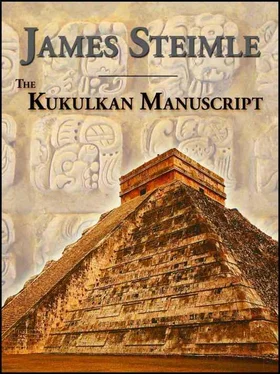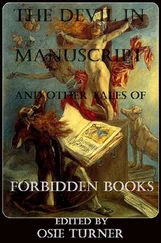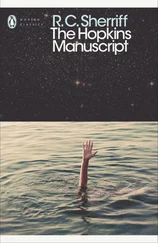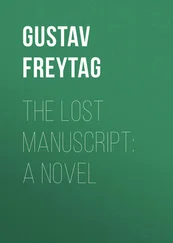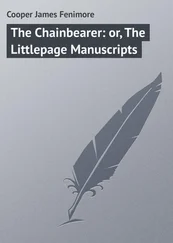James Steimle - The Kukulkan Manuscript
Здесь есть возможность читать онлайн «James Steimle - The Kukulkan Manuscript» весь текст электронной книги совершенно бесплатно (целиком полную версию без сокращений). В некоторых случаях можно слушать аудио, скачать через торрент в формате fb2 и присутствует краткое содержание. Жанр: Прочие приключения, на английском языке. Описание произведения, (предисловие) а так же отзывы посетителей доступны на портале библиотеки ЛибКат.
- Название:The Kukulkan Manuscript
- Автор:
- Жанр:
- Год:неизвестен
- ISBN:нет данных
- Рейтинг книги:5 / 5. Голосов: 1
-
Избранное:Добавить в избранное
- Отзывы:
-
Ваша оценка:
- 100
- 1
- 2
- 3
- 4
- 5
The Kukulkan Manuscript: краткое содержание, описание и аннотация
Предлагаем к чтению аннотацию, описание, краткое содержание или предисловие (зависит от того, что написал сам автор книги «The Kukulkan Manuscript»). Если вы не нашли необходимую информацию о книге — напишите в комментариях, мы постараемся отыскать её.
The Kukulkan Manuscript — читать онлайн бесплатно полную книгу (весь текст) целиком
Ниже представлен текст книги, разбитый по страницам. Система сохранения места последней прочитанной страницы, позволяет с удобством читать онлайн бесплатно книгу «The Kukulkan Manuscript», без необходимости каждый раз заново искать на чём Вы остановились. Поставьте закладку, и сможете в любой момент перейти на страницу, на которой закончили чтение.
Интервал:
Закладка:
Alred forgot about his odor. “You can read this Meroitic?”
“Well,” Porter said, setting the book on his desk and returning sluggishly to his seat. He landed in his chair with a thud and another irritating squeal. “I’m a little slow going, but…yes.”
“Would you please stop doing that,” Alred said, closing her eyes. Her head was obviously throbbing. Either that, or the ideas she was hearing made her want an excuse for a pain reliever.
“What,” said Porter, trying to prop his feet on his desk. He didn’t have much room between his table and the wall and so had to rest the heels of his running shoes on the corner of the desktop.
“Never mind,” Alred said.
“You know…reading KM-2…is easier than translating Meroitic Egyptian.”
Alred stared at him. “It should be C M-2.”
“What?”
“Kalpa should be spelled with a C. I know of no village that starts with a K in Central America,” she said.
He dropped his heels to where they belonged and leaned forward, still unaware of his screaming chair. “Meroitic was developed by a group of people fleeing Jerusalem around the year 600, as I said. The language is a mixture of two Egyptian scripts: Demotic and its mother, Hieratic. Hieratic is simply a shorthand version of the famous Hieroglyphs everyone thinks of when picturing Egypt.”
Alred pointed at the bark page. “You’re saying this is a form of Meroitic?”
Porter shook his head. “Not really. It’s a twist on a Demotic/Hieratic style; kind of a sister to the Meroitic language.”
Alred sat up. “If I’m following you correctly, Porter, you’re saying these ancient Mesoamericans living in Highland Guatemala wrote in an Egyptian language.”
“Of a sort,” Porter said.
“That’s why Kinnard could read this,” she said.
“Well he could and he couldn’t.”
“That sounds scientific,” said Alred, reaching up to wipe her brow. The stickiness was probably growing under her arms as well, and whether or not the headache had ever truly come, Porter could tell she wanted to leave. “You know, Porter, I hate to say this, but it sounds like you’re not proving your Book of Mormon true. I understood you believe Jews settled in Central America.”
“Kinnard had difficulty understanding what he was reading because while he recognized it, he didn’t.” He realized that sounded stupid so he rubbed his mouth with his wet fingertips and started again. “The writing is clearly of Egyptian origin…but it has distinctly Hebraic attributes.”
“What?”
“Moses Maimonides, one of the greatest rabbis and Jewish philosophers of the late twelfth century, worked for a time as a court physician in Cairo. He recorded his thoughts in what may seem to be a peculiar way. His book is quite famous: The Guide for the Perplexed.”
“Sounds like the book we need,” said Alred.
“The language was Arabic,” Porter said with a sniff, “but he used the Hebrew alphabet.”
“He mixed up his languages on purpose?” said Alred, unsure of whether she understood Porter right. Of course it wouldn’t make sense to the casual student, but this was business, so she had to understand.
“Actually, it is not uncommon to find such crossovers in history,” Porter said.
She lifted her eyebrows.
“I have read of Arabic texts scribbled in Coptic characters. There is also the London Magical Papyrus, and then Papyrus Anastasi I, and then other Hebrew works penned in Arabic writing. Papyrus Amherst 63 confused Egyptologists for years until they realized the demotic script formed sentences in the Aramaic language. There are plenty of examples from the earliest times to this very day!”
“Give me an illustration outside of the Near East.”
Porter lifted a hand. “You are probably aware that there’s a lot of French-Latin out in the world-I don’t mean French derived from Latin, but a form of pseudo-Latin. It was written by people who tried to use the language of the well-schooled, but ending up blending their own speech with their writing. Like the folk in the middle ages who wanted to write in illustrious Latin, which was seen as more prestigious than their own language. Whoever wrote our codex, scribed words in the characters of the learned Egyptians while most of the lingo was Hebrew.”
Silent, Alred let it soak in.
“In other words,” Porter said, “KM-2 was written by someone schooled in Egypt, who was a native of Palestine…or one of this man’s descendants. It is well-known that distinguished people studied in Egypt during in the fifth and sixth centuries BC. Many famous Greeks did it. I could start dropping names. Socrates, Pythagoras-”
“Please. Don’t,” Alred said with an uplifted hand. “I read a year ago that Rameses III was the Father of Ancient America. The book was full of evidence suggesting connections between Central America and Egypt.”
“What kind of connections?” said Porter.
“Architecture, art forms, symbols…but I don’t believe Rameses had anything to do with America. Some things just look alike.”
Porter smiled a wry grin.
“You don’t think-”
“No, I doubt there is any relation between Rameses III and Mesoamerica,” Porter said, closing his eyes. “But some of the facts cited in the book might be valid.”
“Two Egyptian figurines were also purportedly found on the west coast of El Salvador. Roman coins dating back to the year 200 have been discovered in North America. but those things could have easily been transplanted.”
Porter nodded.
Alred put KM-2 back on his desk. “I’d like to examine the codex in detail when you can take a break.”
“Sure,” Porter said. He felt the back of his teeth with his tongue.
“So why do you think Albright’s paleographic dating is incorrect,” she said, a sigh in her voice.
“Just a hunch,” Porter said, realizing it was pointless to continue the discussion. Alred’s mind stood solid. She wouldn’t listen. If he said anything else, it would only make her regret her participation in the project more. It was obvious she wasn’t enjoying this. If he was going to work with her, he’d have to be more amiable.
“I see,” she said with a light nod. “I say we subject the codex to carbon 14 dating. We can get Dr. Atkins to do it with little hassle.” She stood. “Unless you have a problem with that?”
“In my first archaeology class,” Porter said, “we…talked about different dating processes. When my professor, Dr. Jacob Noble, told us that many scientists argue the date of a find or question the validity of the year concluded by the tests, I pursued the idea of arguing archaeologists with a string of questions which probably made my professor sorry for writing up the lecture that day. I just couldn’t understand how science could bicker with itself. If the carbon dating’s done, I naively figured…the date had to be right. If it wasn’t, how could scientists continue to use that dating procedure. I asked Noble what would happen if I removed my right ear and had it carbon dated? What year would the process present? He shocked the class by telling us…my ear could be 150 years old.”
“That can’t be true,” Alred said, shaking her head, her eyes drawn into thin slits.
“Right! I would have just cut it off. Two opposing truths cannot exist at the same time. And yet in science, they often do! When I came to Stratford, Kinnard told me that the problem with scholarship is that about fourteen years after you write a paper on a given subject, some other scholar formulates a paper proving what you said to be false. It’s all a big game, with new truths forever overriding old ones. But then, if the discoveries had really been true in the first place, no one could debunk them at any point in the future. So we are not necessarily dealing with truths here, but the redefining of reality. Every scholar wants to make a name for himself-”
Читать дальшеИнтервал:
Закладка:
Похожие книги на «The Kukulkan Manuscript»
Представляем Вашему вниманию похожие книги на «The Kukulkan Manuscript» списком для выбора. Мы отобрали схожую по названию и смыслу литературу в надежде предоставить читателям больше вариантов отыскать новые, интересные, ещё непрочитанные произведения.
Обсуждение, отзывы о книге «The Kukulkan Manuscript» и просто собственные мнения читателей. Оставьте ваши комментарии, напишите, что Вы думаете о произведении, его смысле или главных героях. Укажите что конкретно понравилось, а что нет, и почему Вы так считаете.
